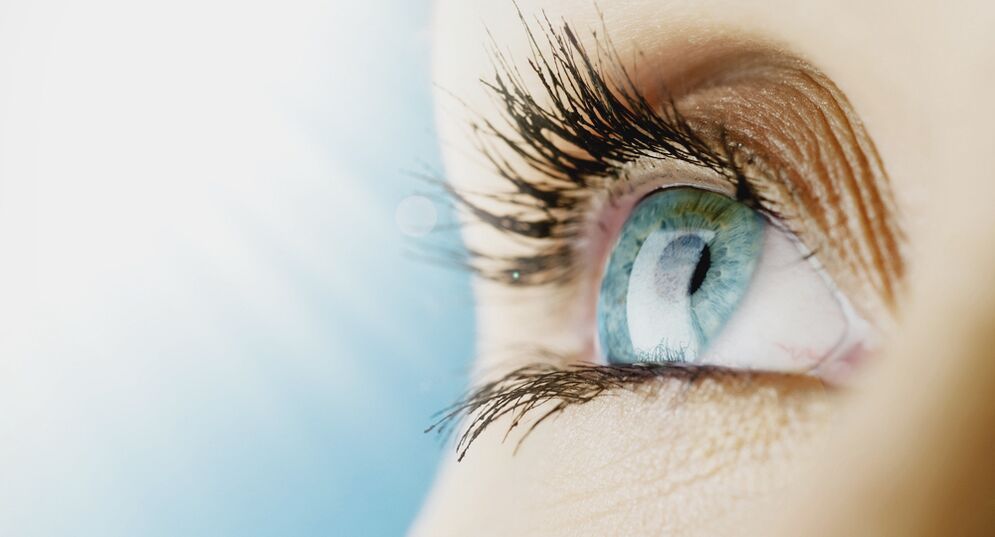
Gymnastics for the eyes, in combination with other techniques, will not only increase the tone of the muscles of the visual apparatus, but also help to improve vision. It is only important not to forget about daily training and to perform the exercises correctly. Before starting gymnastics, you should consult a qualified ophthalmologist. The doctor will make a diagnosis and assess the quality of vision. Today, several effective methods of non-surgical vision improvement have been developed, so it is better to entrust the choice of the optimal method to a specialist.
Rules for practicing gymnastics
Despite the fact that in our time there are several proven and used for medical purposes methods of restoring vision with the help of gymnastics, they must be performed according to the same rules. Therefore, before choosing one or another recovery method for yourself, read the recommendations of ophthalmologists:
- Only gymnastics practiced regularly will bring benefits. The diet must be followed. Choose a gym routine for yourself - twice a day, once in the morning or evening, once every few days. Remember that consistency and the absence of omissions are the key to the effectiveness of the complex.
- Be patient when doing the exercises. You shouldn't even start doing gymnastics if you are in a hurry to get somewhere. The opposite effect will then occur. You risk not using it correctly or, on the contrary, overworking the eye muscles and thus worsening the effect of the gymnastics.
- Do not overdo it. Do not think that the more often you repeat gymnastic exercises, the faster you will feel the healing effect. This is far from true, and with your wasted efforts you will contribute to putting unnecessary pressure on the visual apparatus.
- Maintain intervals. You should not start each new exercise as soon as you have completed the previous one. Sit for about half a minute with your eyelids closed and only after that start doing a new exercise.
- Rest. There is no benefit from doing gymnastics and at the same time constantly sitting at the computer day and night. If you decide to take on the task of restoring your vision, be prepared for the fact that you need to approach this process comprehensively - both from the point of view of nutrition and from the point of view of your daily routine.
Palming according to W. G. Bates
Before starting gymnastics, you need to properly prepare for it. Just like in sports, you can't come from home to the gym and immediately take a heavy weight to your chest. There will be no effect and you risk tearing your muscles, straining your back or getting a hernia. It is the same thing with the visual apparatus. You must prepare it well before moving on to a block of effective and complex exercises.
Ophthalmologists have developed a small complex that helps relax your eyes and prepare them well for the subsequent demands on the muscles during gymnastics. Palming is an essential element of any gymnastics to restore vision.
Palming is a fairly popular and simple exercise for relaxing the muscles of the visual apparatus. This exercise uses both palms. The palming principle includes the following steps:
- It is necessary to warm up your palms. The best way to do this is to rub them together until they are slightly red and warm.
- Bend your palms so that they touch each other with their inner ribs and are located in the same plane.
- Bend your elbows, finding a point of support (for example, a table or knees) and close your eyes with your palms so that only the fingers of one hand are above the other.
- Spend 5 to 7 minutes in this position. If necessary, repeat after a while.
The essence of palming is to cause what is called "flashing" in the eyes. However, you should not put pressure on the eyeballs.
This simple exercise can improve vision and is effective against nearsightedness and farsightedness. When palming, the heat from the palms affects the facial nerves, as well as the eye muscles, relaxing them and providing blood flow. Such regular training can even change the angle of the eyeball, that is, you can count on a noticeable positive effect even with strabismus. You just have to squeeze your fingers as tightly as possible so that the light does not pass through them. It is important that when performing palming you should relax as much as possible, take a comfortable and relaxing position.
At the initial stage of palming, you may experience not entirely pleasant sensations in the eyes, pain and a feeling of pressure "from the inside". This is a completely normal condition and after a few exercises the discomfort will disappear.
Exercise #1. I'm writing to you…
Despite the fact that the previous exercise relieved tension from the visual apparatus, the muscles did not completely relax. This is exactly what we are going to do now. Unfortunately, many people, trying to restore their eyes and relax them as much as possible, forget that the neck is also involved in every exercise, because it also needs attention. It is from the neck region that blood flows to our eyes and thus nutrition is ensured. We will try to do everything to return this process to normal, after numerous violations when working in front of the monitor. To practice gymnastics you will need a chair or mat, as it can be practiced in two positions: sitting and lying down.
To achieve the correct result in gymnastics, you need:
- Adopt a comfortable lying or sitting position.
- Close your eyes.
- Relax.
- Imagine there is a pen attached to the tip of your nose and you urgently need to write a letter.
- Now you can start drawing simple figures or writing entire words, but certainly with your nose, without using your hands.
- The neck must also participate in this process.
- First, try writing the entire alphabet.
- Increasing the difficulty, try to reproduce your favorite verse or at least a few lines from it.
Exercise #2. See through your fingers
Another exercise can relieve fatigue in your eyes. Its implementation is not limited to a certain pose either. You need:
- Bend your elbows.
- Open your fingers.
- Bring your palms to your eyes so that the back of each palm is directly under the eye.
- Now look with your fingers at all the objects in the room.
- The most important thing is not to focus on the fingers themselves, the whole point of the exercise is to see something beyond them.
The exercise can be made more difficult by trying to focus on moving objects in the room. Look in different directions, turn around without moving your hands away from your face. Do the exercise about thirty times, spending no more than five seconds on each attempt to see something in the distance. This exercise will seem difficult to you at first, but over time you will learn to focus on individual things without paying attention to your hands.
| Exercise name | lead time | Number of approaches |
|---|---|---|
| Exercise #1 | 30 seconds | 3 approaches |
| Exercise #2 | No more than 5 seconds | 3 sets of 10 times |
| Warm up | 30 seconds | 2 to 3 approaches |
Solarization: the invigorating power of light
Solarization is a set of exercises, the main active factor of which is bright light.
Solarization can be carried out using:
- Sveta;
- sun;
- candles;
- electric incandescent lamp.
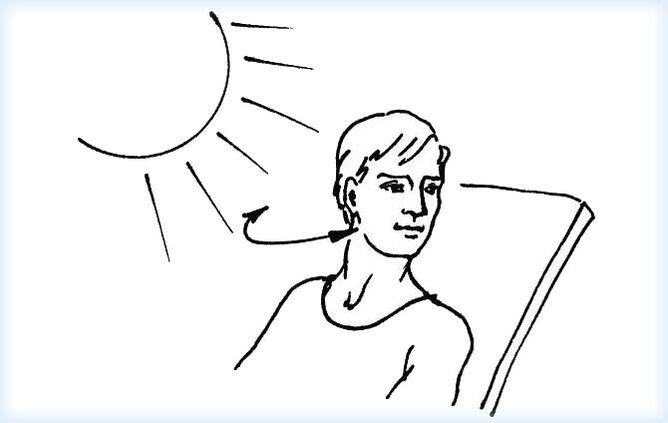
Solarization in the sun is considered the most effective, but it is not always possible to use a natural light source. Therefore, candles and incandescent lamps can also find useful uses.
Solarization is carried out in several stages:
- Position yourself in relation to the light source so that your face is directly facing it. Eyes should be closed.
- Without squinting, try to get used to the bright light (your eyes should always be closed). If you feel pain in your eyes, you can cover them with your palms for a short time, then remove them and try again.
- It is necessary to slowly turn your head, first to the right, then to the left, so that the light can exert its influence evenly.
- Once solarization is complete, do palming.
Solarization is effective in restoring vision. It improves blood circulation and also promotes rapid regeneration of eye tissue, especially in the postoperative period.
Improving blood circulation with gymnastics
Often a person loses vision due to the fact that blood circulation in a certain area is disrupted. It does not reach the necessary muscles and nerves in the required volume, which is why myopia develops and the retina becomes thin. The best thing you can do without surgery is to try to improve your circulation yourself. Massage movements are best suited for this.
| No. | Description | lead time | Number of approaches |
|---|---|---|---|
| Exercise 1 | Using massaging movements, move from the lower part of the eyelid of the right eye to the bridge of the nose, then along the eyebrow part of the left eye and back to the bridge of the nose. So, it's like drawing an infinity sign or glasses. | Do the exercise for one minute | The exercise is performed in 2-3 approaches |
| Exercise 2 | Move your eyes left and right, as if you were moving your pupils along the horizon line. Do it at maximum speed, but so that when exercising there is no pain in the eyes | Within thirty seconds | 2-3 approaches |
| Exercise 3 | Move your eyes up and down, moving your pupils in a vertical line at maximum speed | Within thirty seconds | 2-3 approaches |
| Exercise 4 | Squint your eyes quickly and immediately relax them | Executed 10 times | 2-3 approaches |
| Exercise 5 | Place your index finger on the bridge of your nose. Try to bring your eyes as close as possible to see it. | Hold your attention on your finger for two to three seconds. | Five approaches |
| Exercise 6 | Blink your eyes very quickly | In twenty seconds | Three approaches |
| Exercise 7 | Look through the window. Point to a specific object in the distance yourself. Place a circle on the glass next to the object. Shift your vision from a distant object to a sticker and vice versa | In a minute | Three approaches |
After completing such a complex, the muscles of the visual apparatus will become toned and you will not only receive a therapeutic effect after the first exercises performed, but also prevent various eye diseases associated with poor blood circulation.
Fight myopia with gymnastics
It has been scientifically proven that the most common eye disease is myopia for several reasons. Severe fatigue, constant contact with technical equipment and a lack of rest for the eyes take their toll. Someone loses their sight due to bad heredity, while others are left alone with a sad outcome. But in the meantime, there are exercises that can partially restore vision and also serve as a preventive measure against further vision loss.
To do gymnastics you need to sit down and relax.
| No. | Description | lead time | Number of approaches |
|---|---|---|---|
| Exercise 1 | Close your eyes. Recover. Try leaning back and breathing deeply. Without opening your eyes, lean forward and exhale | Perform for exactly one minute | Two approaches |
| Exercise 2 | Lean on the seat back. Open your eyes. Lean your body forward and suddenly close your eyes, then open your eyes and return to the starting position. | Perform for exactly one minute | Two approaches |
| Exercise 3 | While sitting, place your hands on your waist and turn your head first to one side then the other to see your elbow. | Perform for exactly one minute | Two approaches |
| Exercise 4 | Start turning your eyes clockwise, then counterclockwise | Perform thirty seconds in one direction and thirty seconds in the other direction. | Three trips |
| Exercise 5 | Stretch your arms. Look at your fingertips. Raise your hands, but continue to watch your fingers. You can't move your head. Once you lose sight of your fingers, drop your hands | Perform for exactly one minute | Two approaches |
Movement-Based Gymnastics
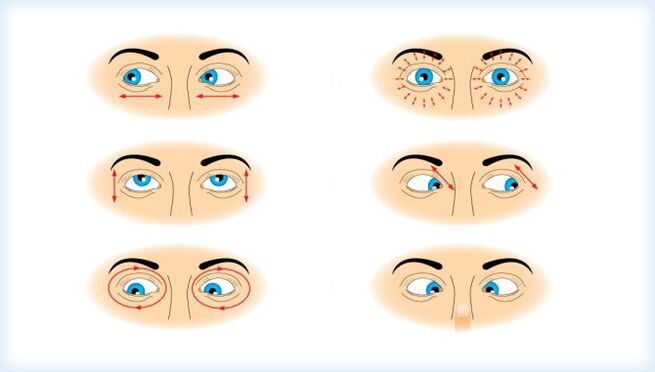
There are several basic types of exercises, from which it is recommended to create individual gymnastic complexes:
- circular eye movements;
- describe geometric shapes with the eyes;
- concentrate the gaze;
- guide lines (up-down, left-right);
- blink/close your eyes.
Exercises that can be used to prevent and treat myopia include:
| No. | Exercise | Description |
|---|---|---|
| 1 | Focus | You need to look into the distance and aim it at the furthest point within sight. Slowly move your gaze towards the tip of your nose |
| 2 | Circular movements | Draw a circle with your eyes. Repeat 10 times. Then do the exercise in the opposite direction. |
| 3 | turn signal | Blink your eyes rapidly for a few minutes |
| 4 | Squeezing your eyes while sitting | Close your eyes for a few seconds, repeat several times |
| 5 | Eyelid massage | Close your eyes and massage your eyelids using circular movements with light pressure. |
| 6 | Contact lenses | Direct your gaze to where the eyebrows grow together, hold it for 2-3 seconds, then return to the starting position and repeat |
| 7 | Head rotation with gaze shift | You need to slowly turn your head to the side, moving your gaze in the same direction. Then turn your head in another direction. |
Effective gymnastics for hyperopia:
- Focus on a distant object. Place your finger at a distance of 30 to 40 cm from your face. Look into the distance, then focus on your finger.
- Read between the lines ". Grab a book, read a few paragraphs of text, then focus on the white space between the lines.
- The head is spinning. Turn your head to the left, then to the right, always looking ahead.
- Observation of moving objects.
After each set of exercises, you should let your eyes rest. You can relax the eye muscles with a light massage or compresses.
Preventive gymnastics
To prevent visual acuity from decreasing, it is necessary to perform the following exercises from time to time:
- "Draw letters. "You must use your eyeballs to outline any number of letters of the alphabet. The exercise can be considered completely completed if you successfully described all 33 letters.
- Open your mouth - close your eyes. At the same time, open your mouth, then open your eyes wide. Try to open your mouth and eyes simultaneously.
- Blink/close your eyes. It is necessary to alternate frequent blinking with squinting for 3 to 5 seconds.
- Massage the upper eyelids with light circular movements.
- Move your gaze up and down.
- Move your gaze diagonally.
- Pressure. You need to close your eyelids and not press too hard on them.
- Look through your fingers. Covering your eyes with your palms, spread your fingers a short distance, look through them for a few seconds and squeeze them tightly again.
- Narrowing. You need to close your eyes, touch the outer corner with your middle finger and pull to the sides. You should feel slight tension in the muscles.
- Tilt your head down, relax your neck muscles and place your chin on your sternum. Direct your gaze toward the ground. Then slowly tilt your head back while looking up.
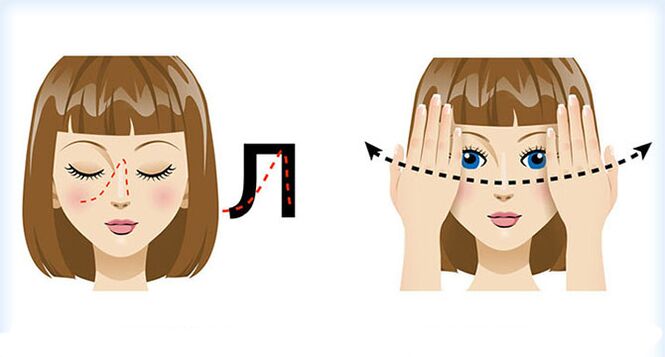
Don't underestimate preventative eye exercises. After all, it is the eyes that are constantly exposed to the most harmful factors. Stress, bad habits, lack of vitamins, frequent illnesses and unfavorable environment often become the causes of sudden and rapid loss of vision.
The table below shows three groups of exercises that provide a set of preventive measures.
| Exercise group | Initial position | Example |
|---|---|---|
| Exercises to strengthen the eye muscles | When sitting, the head is still | Look away to the right, then to the left, without changing the position of the head |
| Exercises to Boost Circulation and Blood Flow | Session | Close your eyes alternately |
| Exercises for accommodation | standing | Fix your hand with an outstretched finger at a distance of 30 cm from your face, focus your gaze on it. Without changing your focus, slowly move your finger toward your face. When it seems that your finger is double, you need to gently return it to its original distance |
For people who spend a lot of time at the computer, working with papers and small print, preventive gymnastics is simply necessary.
Morning exercises for the eyes
Exercising in the morning allows the body to wake up quickly, tones the muscles and gives a good mood for the whole day. What about morning exercises for the eyes? The sensations that result from it are no less pleasant.
Morning exercises can be done in several stages:
- Staying in a horizontal position, stretch, relaxing your neck muscles.
- Several times, synchronously, open your mouth and eyes wide.
- Perform several squints lasting 3 to 5 seconds.
- Then blink frequently, but not very quickly.
- Close your eyelids and use your nose to describe any silhouette in the air. You can thus "write" words, letters or "draw". The duration of this exercise is on average 2 to 3 minutes. The images that arise during such exercise make the brain "wake up" more quickly and get back to work.
- Raise and lower your eyebrows several times. Sometimes frowning, sometimes surprised.
- Lying on your back, do palming.
- Turn your head from side to side for 2-3 minutes. This relieves tension in your upper spine, which is especially important if you have to sleep in an uncomfortable position.
In total, eye exercises in the morning will not take much time, but will produce a noticeable positive effect: after 1-2 weeks, visual acuity will noticeably improve, the number of headaches will decrease and there will be nono sign of fatigue on the face.
Evening exercises for the eyes
In the evening, gymnastics is necessary primarily to relax the muscles of the visual apparatus from daytime tensions. Therefore, here palming will be more associated with exercises aimed at combating myopia and retinal diseases:
- Lie down for a while with your eyes closed.
- Without opening your eyes, rotate your pupils clockwise and counterclockwise.
- Open your left and right eyes alternately.
- Look at an object two or three meters away from you. Shift your gaze to a more distant object. Then again to the nearest one.
- If possible, hang a table with letters, like in an ophthalmologist's office. Every evening, look at the letters, studying the outlines. Remember what you saw initially, how much a week later, and so on.
- Finally, use your fingertips to pull the eyelids, pulling the skin away from the eye. Do this down, up and to the sides for a minute.
Get into the habit of sleeping with a special medical eye patch. This allows you to sleep soundly and your eyes won't react painfully to the morning sunlight sneaking into your bedroom.
Tibetan gymnastics
There are many techniques including various sets of eye exercises aimed at correcting vision, preventing cataracts and treating many diseases associated with the eyes. Tibetan gymnastics is one of the most common and effective. It includes the following exercises:
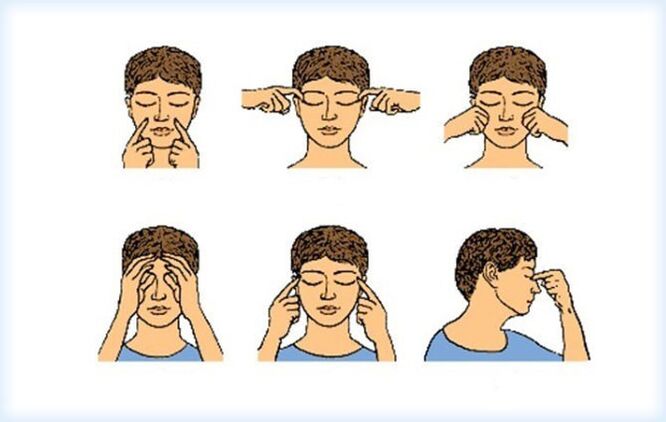
- Peripheral vision training. With your arms extended in front of you, place your two index fingers in front of your eyes at a distance of 35 to 40 cm, joining them. Without changing your gaze, slowly spread your arms with your fingers stretched out to the sides. The goal is to look straight ahead but see the fingers in your peripheral vision. Then bring your fingers together in front of you again.
- Pressure. Lightly and quickly press your fingers to your closed eyeballs, then open your eyes and try not to blink for about 5 to 6 seconds.
- Square. Describe the square with your eyes: look down - left - up - right. Then repeat in the opposite direction: look up – right – down – left.
- Flashes frequently for about a minute.
- Light eyelid massage. Close the eyelids and, using light massages, move from the inner corner of the eye to the outer corner along the upper eyelid, then along the lower eyelid.
Each Tibetan gymnastics exercise should be performed for at least one minute or at least 10-15 repetitions.
Yoga for your eyes
Many people consider yoga to be a treasure trove of health benefits. There are more and more fans of this more-than-sporty lifestyle, year after year, and this is justified. But few people know that yoga exists not only for the body, but also for the eyes. Such exercises will help keep your vision in excellent condition if done systematically until old age.
All you need to do is take a comfortable position while sitting on the floor and straighten your back. Relax and think of something pleasant. Start a set of exercises with a light warm-up, trying to direct your gaze from side to side, while trying not to move your neck and head.
Now that you have moved a little, you can begin the exercises themselves.
- Exercise #1
Get regular, gentle breathing. Try directing your gaze to the space between the eyebrows, thereby practically connecting the pupils at the bridge of the nose. Of course, you won't succeed the first time, but by systematically repeating the exercise, you will succeed. You should hold your pupils in place for at least two seconds, gradually increasing the delay time, over and over again. This exercise should be performed ten times, after each approach giving your eyes a few seconds of rest.
- Exercise #2
Give your pupils a little break after the first exercise, blink your eyes, close your eyelids for a moment and open them gently. As soon as you feel that the tension has subsided, prepare for a new exercise. Your position remains the same. The eyes should be wide open and breathing should be regular. Place your finger on the tip of your nose and try to see it with both eyes. Thus, the students will find themselves at the level of the bridge of the nose, but their gaze will already be directed downwards, unlike the previous exercise. Repeat ten times, giving your eyes some rest in between.
- Exercise #3
Now try to look to the right with both eyes, trying to look as far away as possible, but without turning your body or head. Then look left. Now we repeat the same thing looking up and down. The exercise should not be easy for you: the further you move your pupils away when looking in one direction, the faster you will achieve the desired effect from the complex.
- Exercise #4
While maintaining an even posture and observing smooth breathing, proceed to the next step. Look down without lowering your head. Then begin moving one student clockwise. Once you reach the place where you started the exercise, start moving counterclockwise. Then start making a circle from the top. Do the exercise in twenty approaches, ten each for the eye position above and below. Try to circle your pupils slowly, while trying to see as much of each side as possible.
- Exercise #5
Now you need to relax the eye muscles again so that they stop being tense and feel a surge of strength. To do this, close your eyes, think of something good and, monitoring your regular breathing, rest for a few minutes.
This completes the yoga complex. Many ophthalmologists advise their patients to perform such exercises not only to maintain eye health, but also to feel the therapeutic effect.
Based on the practice of doctors, daily morning and evening yoga classes help strengthen muscles, relieve stress and generally improve retinal health. This means that you can try to recover lost units without the help of surgeons.
It is not necessary to complete only one set of classes, because creating a gymnastics program yourself is not so difficult. This may include exercises, massages, and exercises that relieve fatigue.



















